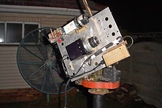X-37B
The pictures of OTV-4 are two-second–long exposures through overhead power and telephone lines. The star cluster shown is Messier 44, and the brightest star is Regulus.
Credit: Greg Roberts
A global team of vigilant satellite watchers has caught the U.S. Air Force's robotic X-37B space plane on camera as the craft circles Earth on its fourth mysterious mission.
The unmanned X-37B launched May 20 atop a United Launch Alliance Atlas V rocket from Florida's Cape Canaveral Air Force Station. Details about the current mission — known as Orbital Test Vehicle-4, or OTV-4 — are classified, but the satellite trackers' new observations are shedding some light on the spacecraft's activities.
"It's in a lower orbit than normal … had us confused for a while, as I thought it would be the standard operating orbit," tracker Greg Roberts, who lives in South Africa, told Space.com. "The inclination is also lower than before." [X-37B Space Plane's 4th Mystery Mission in Photos]
Roberts captured pictures of the space plane in two-second–long exposures through what he called "cursed power and telephone lines."

Greg Roberts of South Africa captured the X-37B space plane using satellite-tracking gear.
Credit: Greg RobertsMission number four
The X-37B is built by Boeing Network & Space Systems, a unit that also designs and delivers satellites used for communications, navigation, intelligence and weather monitoring. The robotic vehicle looks like a miniature version of NASA's now-retired space shuttle.
The Air Force owns two X-37B spacecraft, which altogether had flown three missions prior to the May 20 launch. OTV-1 began in April 2010 and concluded that December after 224 days in orbit. OTV-2 launched in March 2011 and landed in June 2012, after 468 days on orbit. OTV-3 wrapped up in October 2014 after spending 675 days in space.
All of these X-37B missions have intrigued amateur astronomers such as Roberts and Toronto-based Ted Molczan, who are keen to see exactly where the space plane is flying.
Molczan leads a network of citizen satellite observers. He and Roberts organized a team of widely dispersed amateur astronomers, an effort that enabled the detection of the X-37B at the very opening of a visibility window, shortly after OTV-4 launched.
"Tracking down a launch quickly depends as much on organization as it does on orbital analysis. A lone observer can be clouded out for days," Molczan told Space.com. "This almost certainly advanced the discovery by at least several days."

The third mission of the Boeing-built X-37B Orbital Test Vehicle was completed on Oct. 17, 2014, when the craft landed and was recovered at Vandenberg Air Force Base in California following a successful 674-day space mission.
Credit: BoeingOrbit and inclination
The rapid discovery of OTV-4 in orbit has already led to some interesting realizations.
For example, Molczan said that OTV-4's inclination of 38 degrees is the lowest of the X-37B program. The previous low was OTV-1, at 40 degrees. OTV-4 also features the lowest initial altitude — 198 miles (318 kilometers) — of the four X-37B launches. The previous low was OTV-2, at 205 miles (330 km).
"One thing that OTV-4 has in common with each of its predecessors is that its ground track nearly repeats after every 31 revolutions, which takes two days," Molczan said. "This could be in support of a surveillance mission, to permit targets to be revisited frequently, or it may serve some other more mundane operational purpose that we have not discovered."
On previous OTV missions, the duration between repeating ground tracks ranged from two to six days, Molczan said, "so we will not be surprised to see OTV-4 behave similarly."
Such adjustments are readily accomplished by maneuvering the vehicle to make small changes in the orbital period, Molczan added.
The Air Force has not said how long OTV-4 will remain aloft. When the craft does come down, it may land at a site the X-37B program has not yet used: NASA's Kennedy Space Center, in Florida. The three previous missions touched down at California's Vandenberg Air Force Base.
Comments
Post a Comment